2020 brought our world great uncertainty and highlighted room for a lot of change. Pressing issues have positively snowballed into positive action plans among some of the world’s leading businesses, with 8-in-10 executives feeling that business can tackle today’s most pressing problems.
The great news is, we’re starting to see many business leaders forming CSR plans to better our world and fill employees with a greater sense of purpose. Deloitte found that 95% of the businesses they surveyed are devoting substantial resources to CSR initiatives.
“Business is the greatest platform for change…” – Marc Benioff, CEO Salesforce.
It’s fantastic to see that employees’ needs are being answered and acted upon. 1 in 3 employees would prefer to work for a business that shows responsibility towards all stakeholders, not just its shareholders, and 85% of business leaders agree.

This new focus, and action, has resulted in employees needing a greater sense of purpose in their work, and not being afraid to speak up about it. We’re consciously working toward a brighter future for people, and it starts at the workplace.
This article will explore what Employee Purpose is, how it links with your company purpose, different areas of purpose businesses can address, how to create an authentic purpose statement, and the benefits employees with purpose can bring to your business.
What does purpose mean?
In a nutshell, purpose is the reason why something is done, or something exists. With people, purpose defines intentions, and is a quest that many look for throughout their life; it gives people a reason for what they do.

What is Employee Purpose?
Employee purpose is the sense of meaning employees have behind their work and how their values align with a business. It’s all about enabling and encouraging employees to bring purpose to their professional environment and working life. A purpose-driven workplace is one where employees have the opportunity to work on what is meaningful for them.
When it comes to company purpose, it’s about a company’s reason for being; it’s what their founding members saw wrong in the world and wanted to fix. Employee Purpose is what employees see wrong in the world and want to improve—the two are different, but linked by a joint vision for something better.
It’s often connected to a business’s purpose, vision, and mission but can also come with a company’s CSR strategy and employee engagement strategies.
Some examples might include:
- Volunteering (online or physically) to develop their skills and give back
- Monetary and goods donations for causes that matter to them
- Taking care of their physical and mental wellbeing
- Trying new habits to be more sustainable to protect our planet
- Freedom to choose causes that matter on an individual level

A brief history of Employee Purpose
Although a need for a purpose and meaning are an inherent part of the human experience and has always been about, Employee Purpose has grown in the workplace along with Millennials—the purpose generation—joined the workforce.
With a more informed and connected workforce than ever before, and today’s employees are looking for employers that could provide their work-life with more meaning. This need now cuts across working generations, and we see it in an increased demand for CSR.
Fast forward to today, with the crisis of 2020 and Gen Z entering the working world, employers are now sitting in the age of purpose. It’s a time in which all employees want meaning to their work, and they’re looking to their workplace leaders to provide avenues for it.
“You have to connect with the people and world around you, commit to a cause bigger than your own self-interest and, crucially, put yourself to the service of others…” – Paul Polman, Former Unilever CEO.

What’s the difference between purpose, mission, and vision?
Your company’s purpose is supported by your mission and vision statement—it’s at the core of it all. A company’s vision answers what the world looks like when the company is a success.
A company’s mission statement answers how the company intends to achieve that success in the world. A purpose statement answers a company’s reason for being in the first place.
Each drives the other, and in 2020, each needs to be focused around better humanity if it hopes to succeed.
“Innovation cannot advance in a positive direction unless it’s grounded in genuine and continued efforts to lift up all of humanity.” – Marc Benioff, CEO Salesforce.
How to create a purpose statement
Before employees can connect with your company purpose, it’s essential to define it. Start with a purpose statement. Ask yourself what injustice or problem you saw in the world that caused you to picture a better future with your product or service? Whatever that is, it’s your purpose and will often be what attracts employees to you in the first place.
Identify the change you hope to see from the problems you’ve encountered and ask your employees to do the same. You may find your product or service answers many problems than you initially thought—try to find the larger injustice or problem that encompasses it all.
Why is Employee Purpose important?
Employee Purpose isn’t a bonus to having a purpose statement that others agree with, it’s a business strategy that your leadership team works on and strengthens over time— and employees are driving it. 77% of new hires and 76% of current employees are the primary drivers for purpose-driven companies, sitting above customers and other business stakeholders.
It contributes towards business growth goals and employee acquisition and retention goals. Employees that find work meaningful are more likely to be engaged with what they do.
Engaging employees through purpose is about connecting your company purpose with their individual purpose. A study by Mckinsey showed that purposeful employees are more likely—than those not doing so— to sustain or improve their levels of work effectiveness, and have 5x higher signs of positive wellbeing.
The same study also showed purposeful employees are 4x more engaged, and engaged employees bring a wealth of benefits to the workplace, including pulling 147% more earnings per share than competitors with low engagement levels.
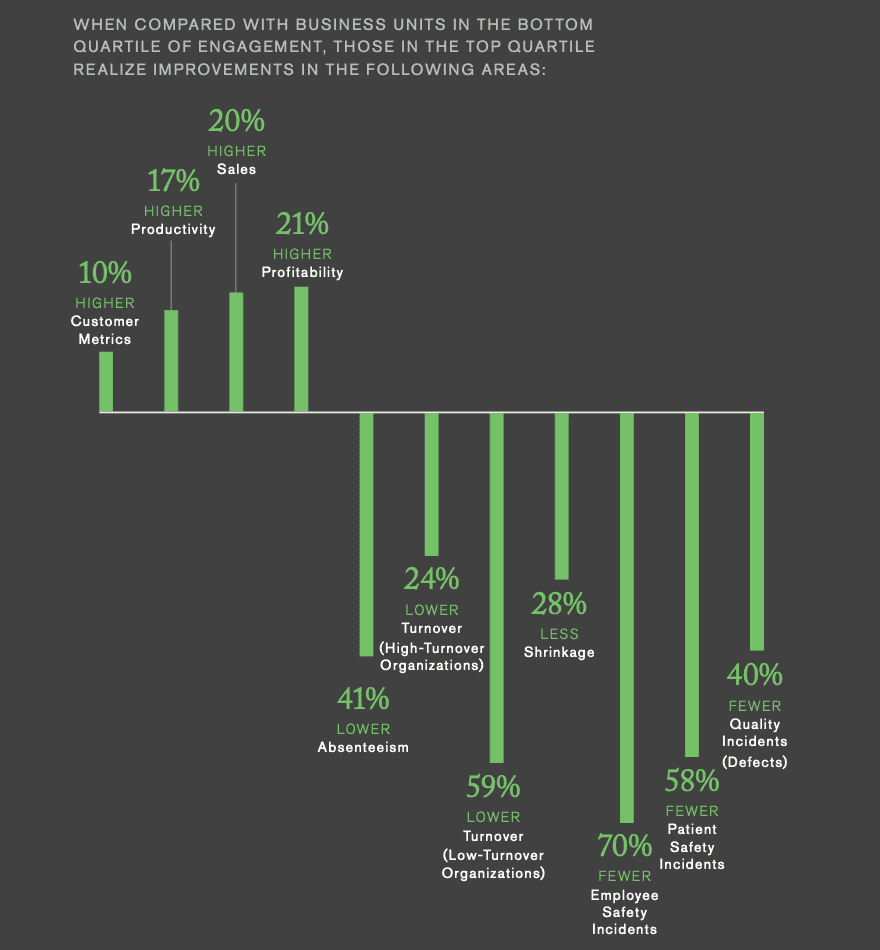
“Profits are in no way inconsistent with purpose – in fact, profits and purpose are inextricably linked.” – Larry Fink, CEO BlackRock.
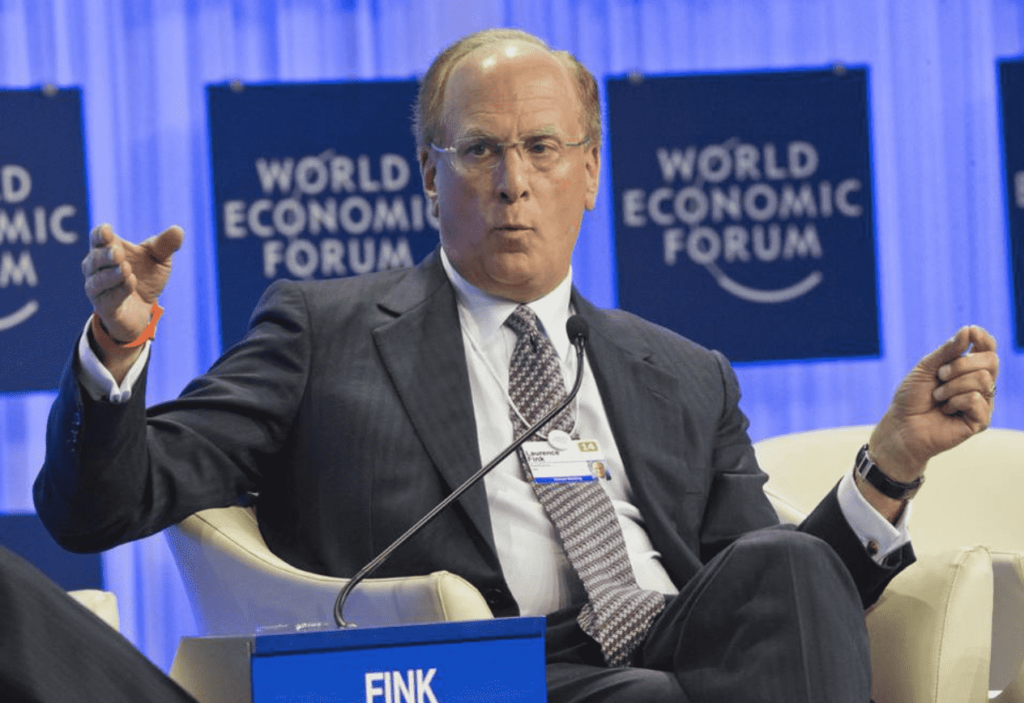
It doesn’t stop at benefits to your business, however. In a day where mental health and wellbeing are at the forefront of our minds, purpose-driven employees have shown greater mental resilience and recover quicker in crisis. They also live longer and happier lives.
What are the different types of Employee Purpose?
With a company purpose defined, it’s essential to understand individual purpose. Many different areas drive Employee Purpose that businesses can focus on. McKinsey found nine types of values that guide individual purpose, and any business can develop strategies to cater to these human needs.
- Achievement
- Conservation
- Caring
- Freedom
- Respect
- Tradition
- Enjoyment
- Stability
- Equality and Justice
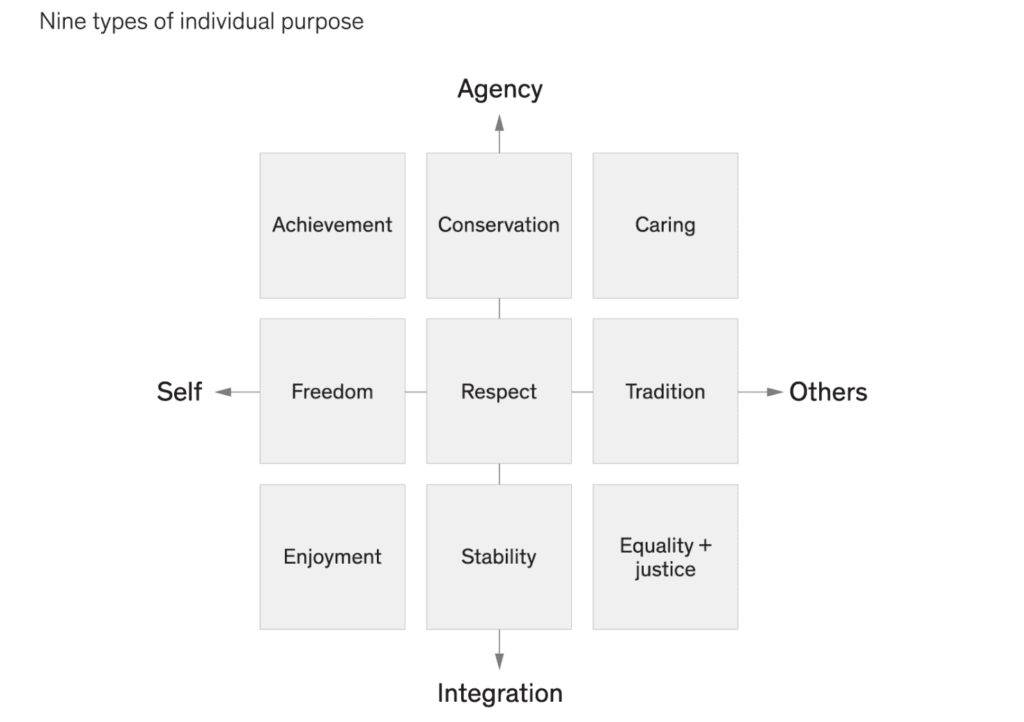
A business can help address all of these in the workplace to some extent by focusing on the following core Employee Purpose areas.
Employee Development
Self-development drives a sense of purpose with individuals, through activities like self-study stipends, coaching or mentoring programs, conferences and workshops, performance reviews, and career planning, the list goes on.
87% of Millennials consider development in a job very important. Any business must offer some form of a development plan to employees if they hope to retain them.
Development opportunities can also be discovered via volunteering opportunities. For example, Johnson & Johnson set up skills-based volunteering programs which have benefited communities as well as employee’s self-development.
Community Development
This area of Employee Purpose leans heavily on corporate social responsibility and is the perfect example of how the two can come hand in hand. If you can pinpoint a community initiative that reflects your company vision, you’ll find employees are drawn towards your CSR efforts and are more engaged all round because of it.
The Porter Novelli executive purpose study found that 80% of executives feel they can solve today’s most pressing problems with purpose-led strategies. Plus, 7-in-10 know they need to take risks to address social justice. You have your what and your why—now you need to work on your how.

Communities can be global, or they can be hyper-local—perhaps you want to focus on the community sitting under your (virtual) office roof?
If you’re hoping to build community, then it can be a great thing to educate and launch sustainability actions, and diversity, equity & inclusion programs. These unite people through awareness and uplift any community, inspiring people to build a better place to live, both emotionally and physically.
Wellbeing Development
In 2020, more companies than ever before are reporting to have a standalone wellbeing strategy— at 44%. The same survey showed that 37% of businesses witnessed an increase in stress-related absence in 2020.
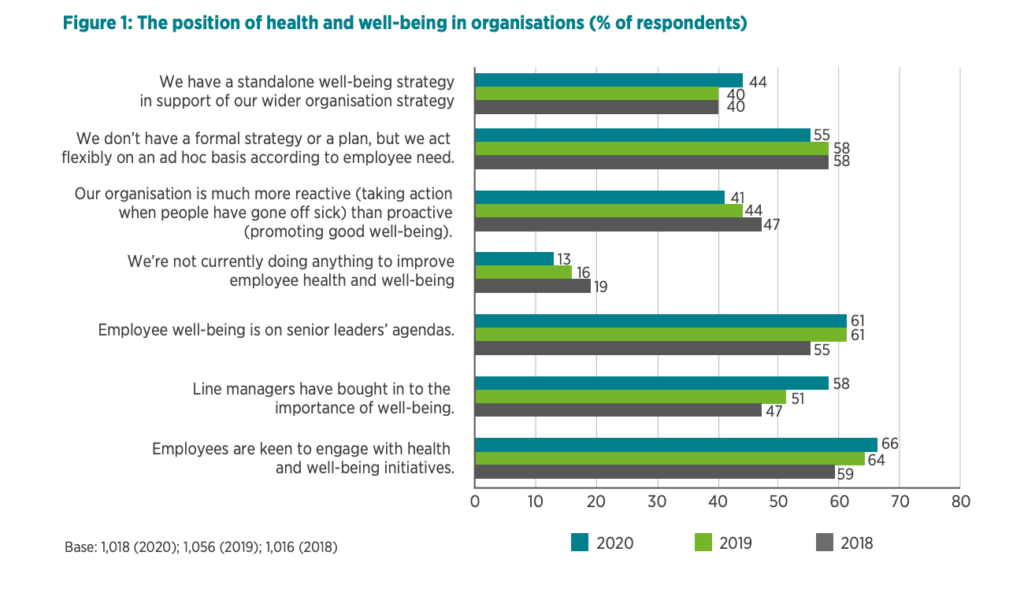
However, more employees say technology is helping to manage all of the above. With remote work, innovative wellbeing apps, and awareness around mental health all on the rise, purposeful wellbeing is a strategy all businesses can shoot for, whatever budget they may have.
Financial Development
There’s been a lot of research showcasing financials are no longer such a core factor in employee retention.
Codility found only 8% of developers ranked salary and benefits as an important factor when working for a dream employer and further studies found a whopping 35% of employees would take a pay cut for a company committed to CSR.
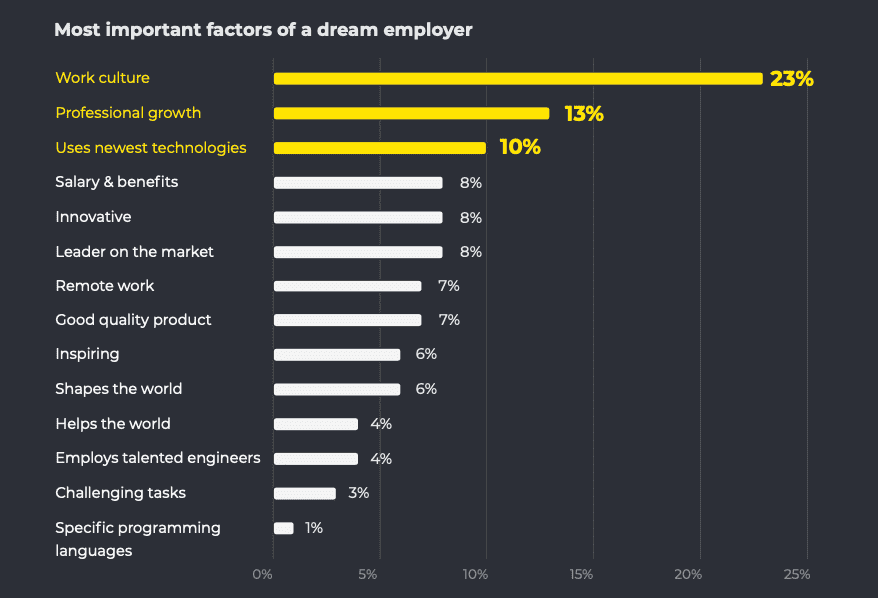
However, there’s no denying the enjoyment, stability, and ability to care for loved ones that financial support provides people. Despite shifting trends in employee needs, financial benefits will always remain of some importance.
Financial development doesn’t need to be one way. People know the importance of money, especially in struggling communities or causes. Give your employees the opportunity to give back with donation programs, so they can support verified causes that they relate to.
If your business is hoping to hit multiple purpose levers of your employees, then the best way to go is to combine a selection of the areas we’ve discussed above. In doing so, you’ll give a wider reach to your Employee Purpose strategy and give it maximum engagement and impact opportunities.
What are the benefits of Employee Purpose?
To recap, as you can see, the benefits for having an Employee Purpose program is massive:
- Increase employee engagement—McKinsey reported that employees with purpose-driven work are 4x more engaged with what they do and engaged employees lead to stronger business outcomes.
- Increase in customer acquisition and retention
- Greater investment opportunities—Research found that purpose-driven missions can increase company market value by up to 6% over a 15-year period.
- Increase employer branding
- Better employee wellbeing— A report from McKinsey found that employees who said they are “living their purpose at work” have 5x higher levels of wellbeing than those that aren’t.
Learn more about the business benefits of investing in employee purpose in our Ebook.

Employee Purpose FAQs
All company needs to do to bring their employee purpose to life is find an employee purpose tool and process to introduce and maintain a purpose-driven initiative among employees.
If you’re ever unsure of your employee’s purpose, there’s an easy way to find that out. Ask them. Develop an anonymous survey so that employees can give their undiluted opinions on their personal sense of purpose.
Companies will tend to have a different purpose to those of its employees. A company’s purpose is why it was created, and the problem it hopes to solve. Employees can often relate to this purpose as it can be a contributing factor to what drew them to the company in the first place.
Leadership needs to develop a clear company purpose to inspire employees, customers, shareholders and other stakeholders to believe in the company and better understand its mission and vision.
Leaders can create purpose-driven workshops in the workplace to help people find their values, ideal culture, and greater purpose. These workshops are best held by an external facilitator with contributions from leadership positions.
Everyone needs to work with purpose if they want to find meaning behind what they do. It will help with creativity, engagement, and attitude towards the everyday.


